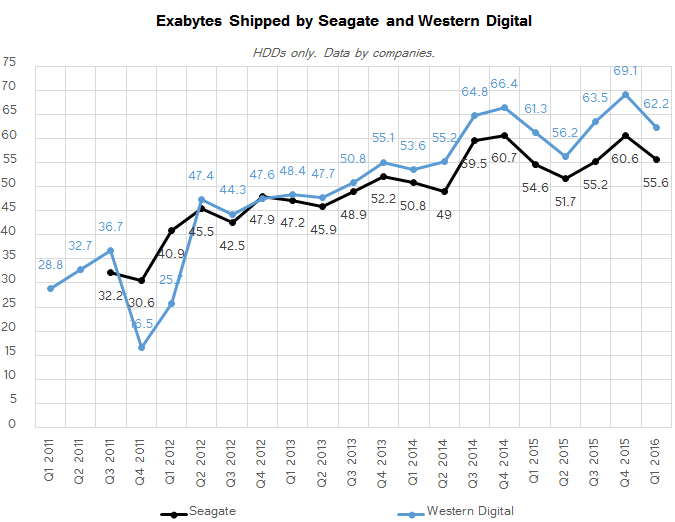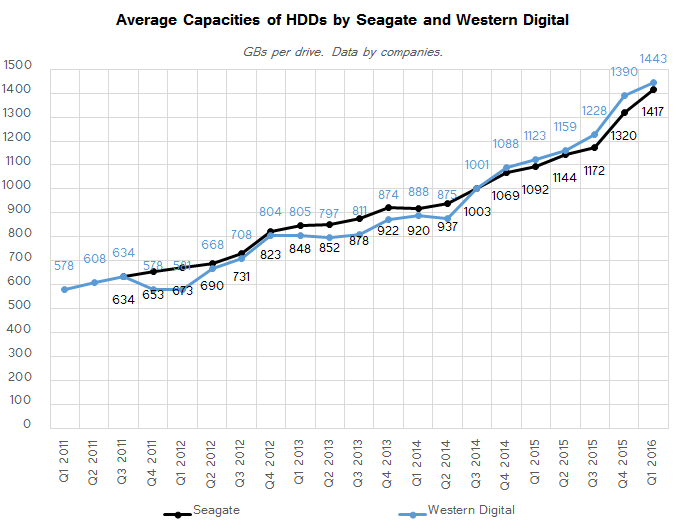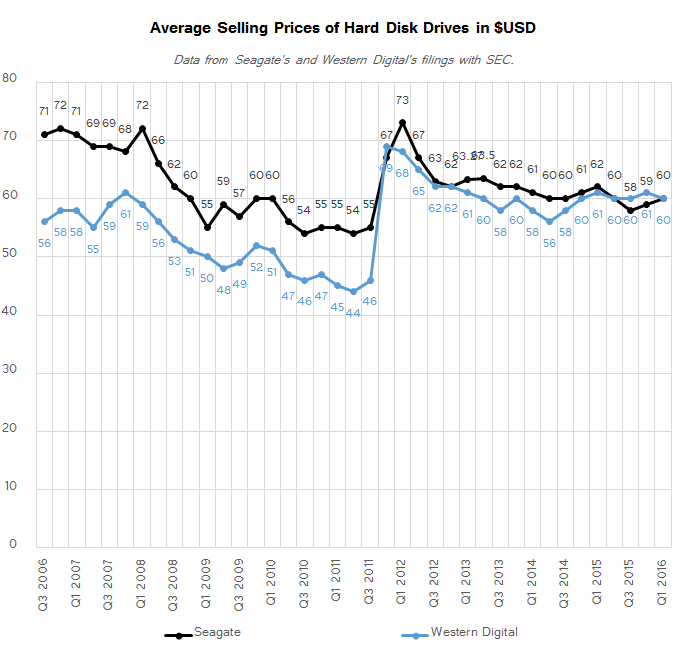Market Views: HDD Shipments Down 20% in Q1 2016, Hit Multi-Year Low
by Anton Shilov on May 12, 2016 8:00 AM ESTAverage HDD Capacities Continue to Increase
Despite the drop in HDD unit shipments, both sequentially and year-over-year, total capacities shipped by the two leading makers of hard drives increased in Q1. Seagate supplied 55.6 EB (Exabyte) of HDD storage last quarter, up from 54.6 EB in Q1 2015, but down from 60.6 EB in the previous quarter. The total capacity of Western Digital’s HDDs shipped in the first quarter of 2016 was approximately 62.2 EB, a moderate increase from 61.3 EB in Q1 2015.
When it comes to hard drives, one thing that has been growing quarter-over-quarter for a long time now is average HDD capacity, particularly in the enterprise segment, but not only there. In Q1 2016, an average drive could store around 1.4 TB of data, an increase of 28.5% (Western Digital) and 29.7% (Seagate) from the same quarter last year.
Average HDD Price Stays at $60 compared to Q1 2015
Despite the local price hikes by HDD makers, the industry can clearly produce more hard drives than it can consume, which is why prices of mass HDD models remain rather low. This will likely change in the future, when consumers shift to higher-capacity drives because of 4K UHD video or other reasons, but right now an average HDD from either Seagate of Western Digital costs approximately $60.
This will likely change after Seagate implements its plans to cut down its manufacturing capacities and supply-demand balance of the market will stabilize. However, it remains to be seen how significantly that is going to change going forward.













116 Comments
View All Comments
yannigr2 - Thursday, May 12, 2016 - link
I have enough space to not buy a hard disk drive the next 2-3 years. I think I bought my last HDD 2 years ago. Probably this is the case with most people and with SSDs taking the place of boot drives, HDD companies are losing the low capacity market.For most people who build new systems, they wouldn't know what to do with all that space a 240GB SSD will offer them. No second HDD for them, not to mention that a 128GB USB flash drive sometimes will do the trick, if they need to clean up some space from their SSD, without having to call the technician to install the HDD. On the other hand, people who need space will go for one 4TB or bigger drive, probably external, instead of buying more HDDs with lower capacities to put into their PC case.
Old PCs have enough capacity, new PCs go for an SSD or just a single high capacity HDD, instead of many with lower capacity.
Gigantopithecus - Thursday, May 12, 2016 - link
This. Last year I built about 30 desktop computers for typical home users (i.e., office/light productivity, HTPC, and gaming rigs) - three had a spinning hard drive in them. The average user is usually fine with a 250ish GB SSD, and if they run short on room, I tell them to buy a pair of 64GB USB flash drives for $20-30 total.Anton mentions the rise of 4K video as potentially spurring more sales of higher capacity hard drives, but I rarely have anyone ask about how to store even BR-D-quality video, so I'm skeptical that 4K will become a serious driver of increased household storage needs this decade. (At least at the consumer level.)
bill.rookard - Thursday, May 12, 2016 - link
The thing is, even if some small percentage do wind up needing more storage (unlikely), many routers these days do actually offer a USB port for attaching and providing access to a HDD. That means even if they have multiple computers or devices, they don't need more than one large capacity HDD for a single household. Heck, you can get a 4TB Seagate external 2.5" hdd (actually twin 2TB's with a USB -> SATA RAID) for $150 at the local Walmart.The net result in the massive increase in HDD storage capacity along with the rise of the medium capacity (250-500GB) SSD means that your average household has gone from multiple HDDs in their laptops/computers to a single central HDD.
Of course, there are exceptions (I have about 30TB of storage here, but I'm an extreme edge case...) so this will continue to be the trend. Your average storage capacity needs for an entire household are increasing far slower than the average increase in HDD capacity vs price.
JeffFlanagan - Thursday, May 12, 2016 - link
Is 30TB really an extreme edge case? Anyone with a serious video collection will surpass that pretty quickly, and if they're using a DrivePool, they'll use at least 60TB in drive space to store that 30TB.OVerLoRDI - Thursday, May 12, 2016 - link
Or Plex peopleLolimaster - Friday, May 13, 2016 - link
Just a collection of movies, anime (h264/HEVC quality) comics andmanga and you're looking at 30TB's for storage in a matter of a few years.Michael Bay - Monday, May 16, 2016 - link
>using hevc before our Lord and Savior Daiz ordered us toBlasphemer.
Gigaplex - Friday, May 13, 2016 - link
I have a storage array of 9TB usable capacity. Of all the people I know personally, only my brother has a larger storage array. While it's quite easy to get larger than that now, it's definitely not common. So yes, I'd definitely consider 30TB to be an extreme edge case in the grand scheme of things.azazel1024 - Friday, May 13, 2016 - link
Yeah, I have to agree with you Gigaplex. I consider my library to be pretty generous. I probably have something like ~500 movies and maybe 30-40 TV series (granted most are just 1-2 seasons, but some are 5-8), plus some music and pictures (and not JPEGs, but a LOT of RAW images since I am a photographer, even if not a professional). Currently on my 6TB array (5.4TiB formatted) I have 2.86TiB free. I still have some older SD content (or there IS no HD version) where I only have the DVD that I ripped and a lot of my BR collection I only ripped at 720p, but right now I am at about 10% 1080p, 50% 720p and 40% 480p content.I wouldn't consider that a small collection, but I don't need anything like 30 terabytes of storage. Maybe if my entire collection was BDMVs instead of transcoded down files. There gets to be a point though where that is kind of ridiculous to do and is absolutely not "common". Hell, I probably represent 1% of computer users as it is, the ones who have all of their DVDs and BRs in unreduced files are probably 1% of the 1%.
At my rate of growth, I've figured I have about 3-4 more years before I need to worry about storage at all (I don't like having less than ~20% free capacity, or about 1TiB free in this case) and maybe somewhat longer as I do occasionally cull my collection when I realize I haven't watched a movie or something since I bought it years ago, so it gets wiped and I either donate the BR/DVD or I'll just stuff it in a box and forget about it. My collection growth is still positive though, but we are talking maybe 20-40GiB a month (buy a few BRs a month, pictures I've taken, etc.), maybe .5TiB a year.
I doubt it'll happen, but some of me hopes that TLC/3D NAND SSDs are cheap enough by the time I am hitting my self imposed limits just to replace spinning disks in my desktop and server (data is mirrored between them and on 2x3TB RAID0 arrays, plus an external 5TB USB3 disk as a 3rd copy). Probably still too expensive, but I can hope the prices are lower enough and I have the budget to pony up $500-700 to replace the disks in both machines with SSDs (hoping and figuring maybe in 4 years the price of cheap SSDs has dropped under 5 cents per GB). Even if SSD storage is <20%, the beauty there is they are so much faster, no worries about arrays and I can just create a storage pool and add SSDs to it as capacity starts hitting <10% free.
I only have 2Gbps throughput on my network right now (SMB Multichannel, dual 1GbE links). Though I am also hoping in 4 years 2.5GbE or 5GbE networking gear will be on the market...so even SSDs might be a bottleneck on my network some day (but I think I can probably live with that. I'd love multi GB/sec throughputs on my network, but I am barely realistic enough to know I don't actually need it at all, 200+MB/sec is plenty and not worth the cost to try to realize more than 300 or 400MB/sec in the next few years).
Wolfpup - Thursday, July 14, 2016 - link
Oh yeah, RAW images...I wasn't even thinking about that. If you're any kind of remotely serious photographer you'd need gigantic piles of storage too.I remember like early 2000s I had like an 80GB drive in my main system, which was fine. Storage requirements have just absolutely ballooned since then though, while it seems like the rate of drive size increases has massively slowed.